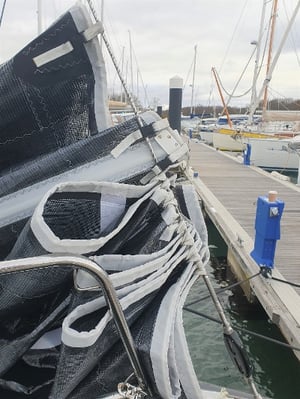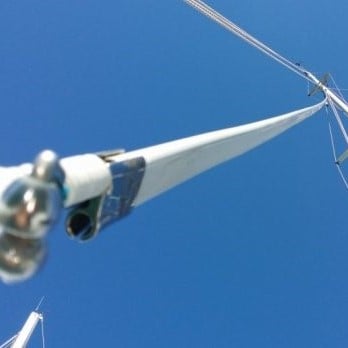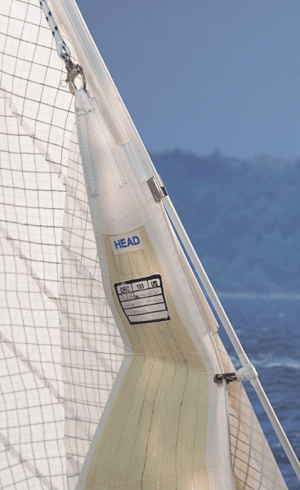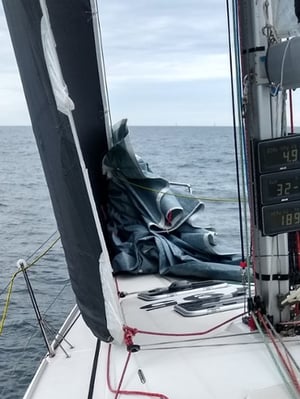-1.jpg?width=495&height=371&name=main%20image%20(3)-1.jpg)
For racing yachts and cruiser/racers with a fixed (non-furling) headstay there are really two possible methods of attaching the luff of the jib to the wire or rod forestay: in a luff foil, or with hanks. In our recent survey of the UK doublehanded fleet we found 56% of respondents using luff foils compared with 38% on hanks. In this blog we explore some of the things to consider when making this choice.
The options
Before we get started, a quick summary of hank and luff foil options. Traditional brass piston hanks have been around for ever and anyone who has used them will be familiar with trying to wrestle a seized hank off a forestay with cold fingers. Modern soft hanks are a significant step forward. These have a few different permutations but are essentially a Dyneema loop or webbing strap with closing method: toggle, buckle, diamond knot etc.

Image credit: Calanach Finlayson
In the luff foil category, there are 2 brands which dominate: TuffLuff and Harken Carbo Racing Foil. These products serve exactly the same function of creating a groove up the length of the forestay for a luff tape with a bolt rope.

Image credit: Schaefer Marine
Handling
The biggest factor in hanks vs foils is undoubtedly the handling during manoeuvres. So let’s break this down.
Hoisting & Dropping
With hanks, the sail is always securely connected to the forestay even when dropped. A hanked jib does not require any kind of feeder and can be reliably hoisted from the mast or cockpit every time without running forward. While a hanked sail can still fall outside the rail when dropping, it is not at risk of being swept under the boat. In summary, a jib with hanks can go up and down with far less handling and risk than a jib with luff foil. That’s a big plus for shorthanded sailing.
Peeling
Peeling is the process of changing jibs while racing, and this is where the aforementioned characteristics of hanks quickly become a hinderance. Peeling jibs with a twin groove luff foil involves hoisting the new jib in the secondary groove, transferring the load onto a new sheet and lowering the old jib. While there is typically considerable friction from hoisting/dropping the jibs against each other, this is undoubtedly the most efficient way to change headsail without slowing. A well practiced peel with a luff foil can result in virtually zero loss in boat speed.

Image credit: Schaefer Marine
Peeling with hanks is a different story which goes roughly like this:
- Hank the new jib onto the base of the forestay to windward of the current jib. This may require undoing one or two of the lower hanks of the working jib.
- Attach a new sheet
- Drop the old jib and unhank as quickly as possible
- Drag the old jib out of the way to windward
- Swap the halyard onto the new sail and hoist
No matter how slick you make this manoeuvre, there will always be a time spent bareheaded, sailing without a jib.

Image credit: Calanach Finlayson
Aerodynamics
We have looked at the practical aspects of hanks vs foils, but what about the aerodynamic performance? Intuitively we might think that a luff foil has obvious aero benefits, creating a cleaner entry at the front of the jib. You can also consider that the luff foil surface area is effectively an additional portion of sail area. But how significant is any of this? We asked a couple of sailmakers whether they had an in-depth numerical analysis and the answer in both cases was no. Alistair Chaplin of OneSails GBR South gave us the following quote:
“We haven't undertaken a study of the aerodynamics of this, as several decades of experience on the water has never suggested to us that there is any measurable difference in aerodynamic performance between the two systems that has real world relevance. One could surmise that the luff foil, giving a slightly fatter, cleaner and more stable leading edge would have a very slight performance advantage over a hanked sail, with a smoother flow and a slightly larger drag bucket (the range of angles of attack that generate the optimal L/D ratio, but I believe that any possible benefit would be tiny fractions of one percent. The fact that I can think of no rating rule, since the IOR, that cares if you have a foil or not implies that this is not significant to sailing performance. Indeed, the IOR only measured the chord of the foil section and added it to the LP of the headsail to quash the start of a trend towards very wide foils as a way of gaining 'free area'. I think that boat handling preferences are a far stronger driver as to whether hanks or a foil are the right way to go on any particular boat.”
Reliability/longevity
A final quick note on durability. Luff foils which are left permanently on the forestay will eventually become brittle, particularly in regions where they are exposed to significant UV. The result is that luff foils have been known to split and fail during a race. Without the ability to hoist a headsail, this is often game over.
Soft hanks will wear over time but the wear is very visible and individual hanks can be replaced. In most cases the hanks will last the lifespan of the jib anyway.
To summarise
- Hanks provide security and ease for sailing shorthanded
- Luff foils offer quicker peeling between jibs
- The possible aerodynamic benefit of a luff foil is far outweighed by the handling considerations
- Luff foils degrade with UV exposure which can lead to failure if not kept in check
If you have any questions please feel free to email us at support@upffront.com, or click the link below to see our full range:



